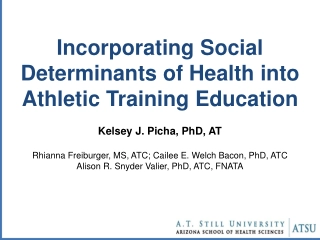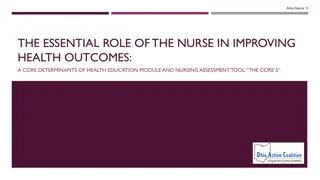
Social Determinants of Health and Their Impact
Explore the concept of social determinants of health and their influence on individual and population well-being. Learn about upstream and downstream factors, intersectoral action, and the historical shift from technology-driven approaches to a holistic understanding of health determinants.
Download Presentation

Please find below an Image/Link to download the presentation.
The content on the website is provided AS IS for your information and personal use only. It may not be sold, licensed, or shared on other websites without obtaining consent from the author. If you encounter any issues during the download, it is possible that the publisher has removed the file from their server.
You are allowed to download the files provided on this website for personal or commercial use, subject to the condition that they are used lawfully. All files are the property of their respective owners.
The content on the website is provided AS IS for your information and personal use only. It may not be sold, licensed, or shared on other websites without obtaining consent from the author.
E N D
Presentation Transcript
What good does it do to treat people's illnesses ... then send them back to the conditions that made them sick?
Upstream/downstream: a story Think Upstream
Determinants of health Determinants of health is the term used for those factors that have either a positive or negative influence on physical and mental health at the individual or population level.
Determinants of health These determinants can be broadly divided into the following three categories: upstream determinants including education, employment, income, living and working conditions midstream determinants including health behaviours and psychosocial factors downstream determinants, which includes physiological and biological factors https://www.health.qld.gov.au/stayonyourfeet/injury_prevention/social.asp
McKeown's analysis The main driving forces behind mortality reduction were changes in food supplies and living conditions.
The 1950s: emphasis on technology and disease-specific campaigns new antibiotics, vaccines and other medicines in this period The sense that technology held the answer to the world's health problems. National health systems urban-based curative care
The 1950s: (Remains) vertical programs narrowly focused, technology-driven campaigns targeting specific diseases such as malaria, smallpox, TB a few notable successes, most famously the eradication of smallpox.
The 1960s and early 70s: the rise of community-based approaches .
1970s locally recruited community health workers Health education and disease prevention rural rather than urban health care preventive rather than curative services
The crystallization of a movement: Alma-Ata and primary health care International Conference on Primary Health Care, sponsored by WHO and UNICEF at Alma-Ata, Kazakhstan, in September 1978 Health for All by the Year 2000 , with primary health care (PHC) as the means Good health at low cost
1980s The First International Conference on Health Promotion co sponsored by the Canadian Public Health Association, was held in Ottawa in 1986. Eight key determinants of health: peace, shelter, education, food, income, a stable eco-system, sustainable resources, social justice, and equity
selective primary health care maternal health and child health a few simple interventions could dramatically reduce illness and premature death ) . . ( . Social justice and social equity .
SDH approaches at country level Canadian Report (1974) and the Black Report in the United Kingdom (1980). Tarlov (1996) Four categories of health determinants: genetic and biological factors; medical care; individual health-related behaviors; and the "social characteristics within which living takes place".
Conclusion The roots of most health inequalities and of the bulk of human suffering are social: the social determinants of health.
Social Determinants of Health: The Solid Facts - social gradient - stress - early life - social exclusion - work - unemployment - social support - addictions - food - transport - World Health Organization, 1998
Why Emphasize Social Determinants? Social determinants of health have a direct impact on health Social determinants predict the greatest proportion of health status variance Social determinants of health structure health behaviours Social determinants of health interact with each other to produce health
Poverty and Health: Mechanisms Poverty can affect health in a number of ways: income provides the prerequisites for health, such as shelter, food, warmth, and the ability to participate in society; living in poverty can cause stress and anxiety which can damage people s health; low income limits peoples choices and militates against desirable changes in behaviour. - Benzeval, Judge, & Whitehead, 1995, p.xxi, Tackling Inequalities in Health: An Agenda for Action.
Defining Poverty Individuals, families and groups in the population can be said to be in poverty when they lack the resources to obtain the type of diet, participate in the activities and have the living conditions and amenities which are customary, or at least widely approved, in the societies to which they belong. They are, in effect, excluded from ordinary living patterns, customs and activities encouraged, or -- Townsend, 1979, p.31
Ten Tips For Better Health - Donaldson, 1999 1. Don't smoke. If you can, stop. If you can't, cut down. 2. Follow a balanced diet with plenty of fruit and vegetables. 3. Keep physically active. 4. Manage stress by, for example, talking things through and making time to relax. 5. If you drink alcohol, do so in moderation. 6. Cover up in the sun, and protect children from sunburn. 7. Practise safer sex. 8. Take up cancer screening opportunities. 9. Be safe on the roads: follow the Highway Code. 10. Learn the First Aid ABC : airways, breathing, circulation.
Ten Tips for Staying Healthy Don't be poor. If you can, stop. If you can't, try not to be poor for long. Don't have poor parents. Own a car. Don't work in a stressful, low paid manual job. Don't live in damp, low quality housing. Be able to afford to go on a foreign holiday and sunbathe. Practice not losing your job and don't become unemployed. Take up all benefits you are entitled to, if you are unemployed, retired or sick or disabled. Don't live next to a busy major road or near a polluting factory. Learn how to fill in the complex housing benefit/ asylum application forms before you become homeless and destitute. 1. 2. 3. 4. 5. 6. 7. 8. 9. 10. Dave Gordon, 1999
Poverty and Health: Literary Perspectives We know what makes us ill. When we are ill we are told That it s you who will heal us. When we come to you Our rags are torn off us And you listen all over our naked body. As to the cause of our illness One glance at our rags would Tell you more. It is the same cause that wears out Our bodies and our clothes. Bertolt Brecht, A Worker s Speech to a Doctor, 1938.






